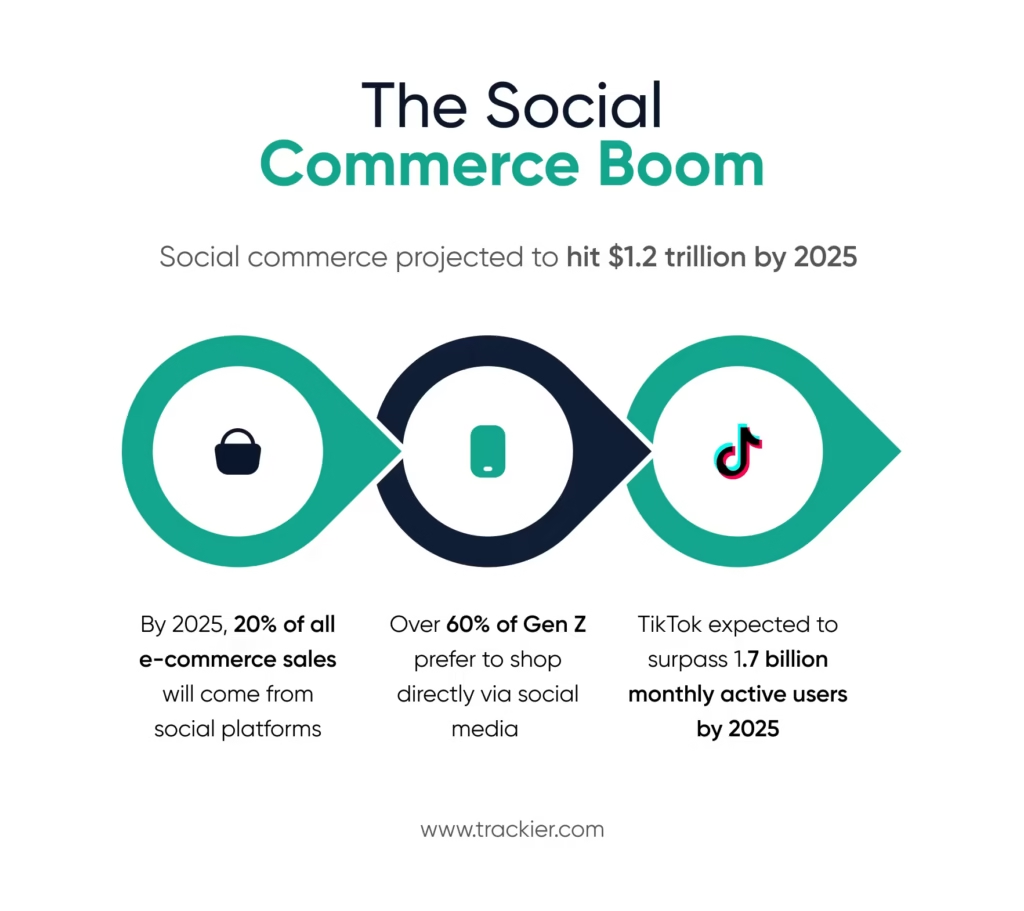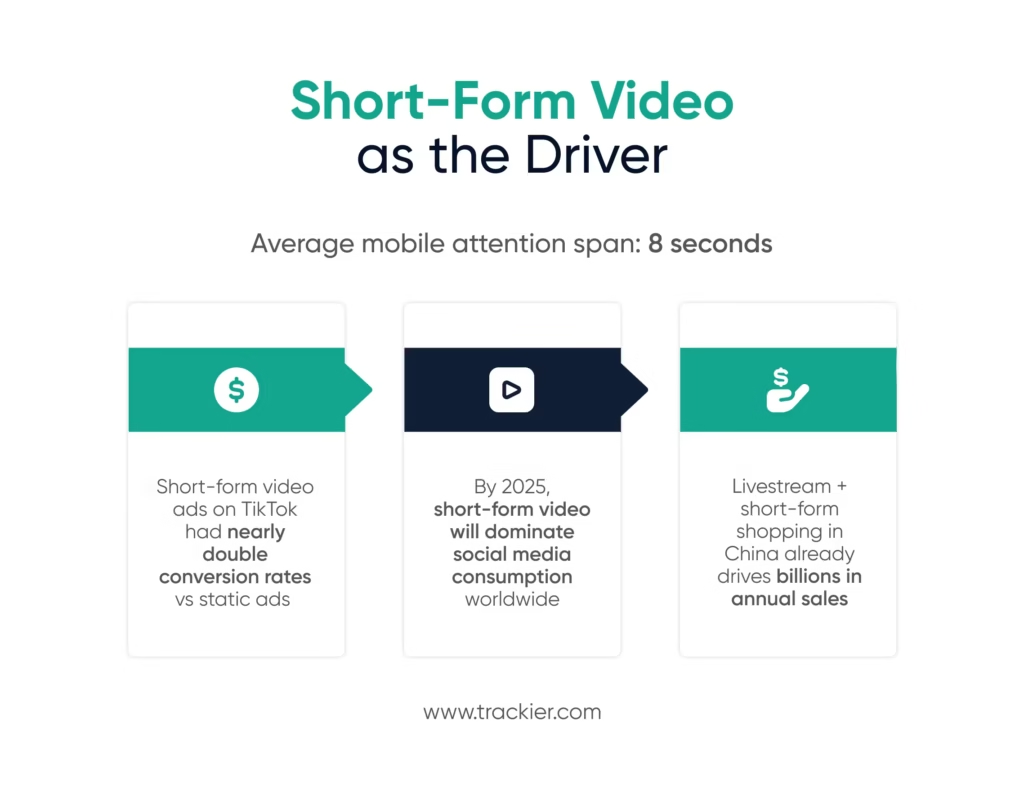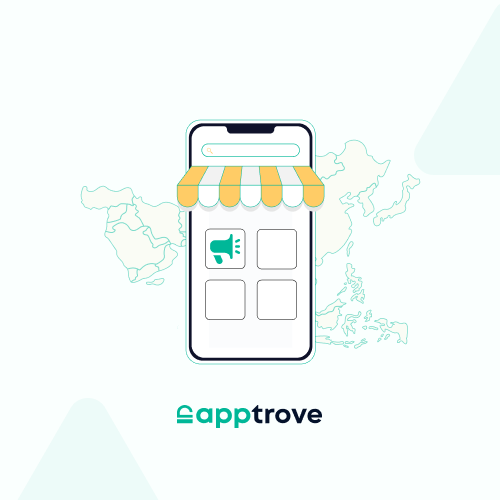Introduction
The way we shop online is changing faster than ever. Just a few years ago, it was basically expected that interactions happened through a single click banner ad + or to a typical web page. Now, shopping often occurs directly within the apps that we spend our time with. Shoppable ads, which are interactive ads allowing people to purchase a product in a single step without leaving their social feed, are changing the way we think about ads themselves.
These changes are driven primarily by two drastically accelerating trends: the growth of social commerce and the growth of short-form video. Social commerce on platforms such as TikTok, Instagram, or YouTube is already projected to be a $1.2 trillion market by 2025, according to Accenture. The same report states that short-form video, in particular, is the new preferred way of discovering products. TikTok alone expects to have over 1.7 billion monthly active users by 2025, and most of those users are shopping and searching for products as they mostly consume product demo and review content, as well as additional content from creators.
For brand marketers, this means that ads are now not passive interruptions; they can instead become passive ad experiences. Shoppable ads are seamless enough that a quick swipe through a video can result in a completed sale within seconds. This report will review how shoppable ads, social commerce, and short-form video will eventually converge to define the future of shopping in 2025 and beyond.

The Evolution of Shoppable Ads
Advertising has always kept pace with how people spend their time. After relying for years on passive ad placements with pretty standard, non-interactive banner ads, brands were able to begin incorporating video into their ad strategy, with platforms like YouTube or Facebook. As people began to shop on apps and not just websites, there became a need for a new ad format; this is when shoppable ads began to take off.
Shoppable ads were basic at first – you touched a product tag in an Instagram post, which directed you to a website. This extra step then added a friction point, which many consumers did not fulfill. With technology evolving, some platforms and app experiences began to integrate the buy button into the ad experience and consumers were able to purchase with one tap on a hoodie within a video or the lipstick in a carousel reel. This is what made shoppable ads one of the fastest-growing ad formats in 2025 and is forecasted to surpass 20% of total digital ad spend this year.
The rise of social commerce accelerated this evolution. People trust what they see in feeds from creators, friends, and their community, which means advertisers need ads to blend in. Short-form video has boosted this evolution. Quick, entertaining bits of content staple viewers’ time, but also inspire impulse purchases. Research by Insider Intelligence reveals that nearly
If we’re being honest, looking back at the transition from static banners to today’s shoppable ads shows just how much advertising has changed from a system of promoting products to facilitating experiences. And with social commerce and short-form video at the core of cultural dynamism, advertisements are not just a fringe tool anymore—they’re defining the future of shopping.
Shoppable Ads in 2025 – What’s New?
Shoppable ads in 2025 are no longer a fun project; they are a core strategy for digital marketers. What makes this year different is the seamlessness and interactivity of the experience. Instead of taking the attention away with a click from an advertising post, consumers will be able to buy quickly, often before leaving the video.
One of the biggest advancements—frictionless checkout. Industry data shows 70% of online buyers abandon their shopping cart when they don’t have a smooth/quick process—TikTok and Instagram have already incorporated one-click purchase options into their shoppable ads, and changed the game with more intuitive pathways. This minor change made a huge difference in savings conversion and encouraged instant gratification among consumers.
Artificial intelligence has changed how ads work. Shoppable ads in 2025 will be dynamically personalized ads in the moment. In the case of a beauty tutorial, the ad may come up as their perfect shade of foundation. That is so personalized to you that it feels like an extra service, rather than they marketing to you.
One of the other emerging trends is hybrid formats. Livestream shopping is blending into short-form videos, giving viewers quick bites of product demos to ultimately direct purchase. In China, it’s already working with billions in sales via Douyin!
All of this is being driven by social commerce, which comes naturally to younger customers. Research shows that more than 60% of Gen Z prefer to shop through social media than e-commerce. With short-form video driving discovery and shoppable ads allowing for instant purchases, 2025 is shaping up to be the year when shopping and entertainment collide completely.

The Role of Social Commerce in Driving Shoppable Ads
The quick rise of shoppable ads could not be possible without social commerce. With shopping, it has always been and will always be about trust—shoppers are more okay purchasing when they see other people using and supporting products. Today, social platforms are our marketplace—they influence our purchases every day through friends, creators, and communities.
According to eMarketer, social commerce is expected to account for nearly 20% of total global e-commerce sales by 2025. By that point, it will be difficult to ignore the fact that platforms have now made shoppable ads a large component of the shopping experience. Instead of looking at shoppable ads like “ads,” they often feel like just an extension of the content they are already consuming. An example is when a favourite creator posts a short-form video reviewing sneakers, after the product tag leads to a purchase, a creator can seamlessly turn engagement into converted interest with only one click.
The role of creators is also a huge part of this movement. Distinct from celebrity endorsements in past advertising, micro- and nano-influencers are relatable and feel like “real people” as compared to other influencers. Creators paved the way to influence near billion-dollar sales through trusted recommendations with shoppable ads that can look like regular content. It is this trust that generates comfort in buying directly through social commerce.
The significance of short-form video can not be underestimated. Quick clips can showcase products in action, highlighting how products..
Short-Form Video as the Perfect Vehicle
If there’s one format that makes shoppable ads work best in 2025, it’s short-form video. These short clips—generally under a minute, but really anything under 90 seconds—are the ideal format for the way people consume content today. They are a joy to watch, simple to consume, and perfect for discovery. Pair this with shopping capabilities, and it turns scrolling into spending seamlessly.
Why does this format fit so well? Research repeatedly shows that mobile attention spans are getting shorter and shorter. A Microsoft study conducted in 2021 noted that the average attention span in the smartphone age is now eight seconds on average, before moving on. Short-form video meets this example by getting the message across quickly and keeping the viewer’s attention. When products are showcased entertainingly and compellingly, it feels like organic content rather than a forced advertisement.
And the fact that the ad is in a short clip makes it more effective. As indicated in a TikTok campaign in 2024, ads that were embedded with a creator-led short video on TikTok had conversion rates that were nearly double traditional static ads. While still effective, it is relatively easier to trust a product when you see it in action, watching someone using a lipstick, for instance, or a gadget solving a problem in their life. This short example is an advertisement and is based on potential impulse buying.
Along with the fact that social commerce relies on being social and sharing, people comment, tag friends, and remix videos with similar content.
In conclusion, short-form video is not just a passing trend; it is the ideal environment for shoppable ads. It encompasses entertainment, social interaction, and immediate purchasing within one seamless experience. As platforms refine tools for ads, we will see these ads become more immersive, more interactive, and a much more central shopping experience in a digital-first world.

Industry Trends and Data in 2025
The year 2025 marks a tipping point for shoppable ads. Once a fringe experiment, shoppable ads have taken root as a major player in global advertising. Brands are shifting their budgets from traditional display campaigns to formats that tie commerce to entertainment across all industries. Per Statista, spending on shoppable ads will break $140 billion in 2023 globally, accounting for more than 20% of all digital ad spend. Shoppable ad growth is largely a result of the explosive growth of social commerce, which is poised to contribute more than $1.2 trillion in sales globally by 2025. The unique value of the combination of entertainment and instant shopping creates a loop where consumers not only consume content, but they shop in the same instant.
Geographies show how adoption varies across regions. For example, in Asia-Pacific, platforms like Douyin and WeChat are doing it best, and shoppable ads are simply part of everyday shopping. Adoption in the U.S. and Europe has been slower, but it too is catching up quickly, as TikTok Shop, Instagram Checkout and YouTube Shopping gain momentum. Short-form video will be the dominant consumption mode and lever action in social shopping around the world.
Demographics also play a key role in the success of shoppable ads. Generally speaking, Gen-Z and Millennials are the preeminent users of shoppable ads.
The data is pretty clear: shoppable ads are no longer a nice-to-have for brands, they’re the cost of doing business. As more users expect seamless ways to shop quickly in the apps they know and love, companies that don’t keep up run the risk of fading into obscurity in today’s shopping-as-last-swipe kind of context.
Challenges & Risks of Shoppable Ads
Shoppable ads are revolutionizing the shopping experience in 2025, but they are not without pitfalls that brands need to face. Shoppable ads have improved quickly, but overcoming issues around trust, privacy, and long-term intent will be critical.
Consumer trust is one major problem. While most consumers enjoy shoppable ads and the shopping experience, some consumers are still fearful of linking payment information directly to their social apps. A recent survey from PwC reported that almost 35% of online shoppers are worried that their data will be misused in social commerce. For these sceptical users, privacy issues can delay adoption of shoppable ads, regardless of how smooth the experience may seem.
An additional risk comes from overdependence on platforms. Many brands investing in shoppable ads rely heavily on an ecosystem (e.g. TikTok, Instagram, YouTube) for their social commerce. As few of these platforms furnish brands with comprehensive data about user experience, brands face scalability challenges as the platforms act as “walled gardens,” retaining information around data, measurements and insights. So while short-form video provides strong engagement, brands still have serious challenges proving long-term return on investment because visibility of sales attribution and metrics is not possible when their views are fragmented.
Ad fatigue, despite the relatively new strategy, could occur. If feeds are filled with shoppable ads, customers may feel overwhelmed or tune out. As a community of providers, it would be better if brands reduced the prevalence of genuine content and found some balance between the authenticity and objectivity of branded content. This is especially important when attempting to monetise short-form video or livestreaming, as audiences expect more entertainment value during those interactions.
Finally, regulation adds complexity. With tougher laws like GDPR and current updates to CCPA, platforms should consider the ways in which they leverage consumer data to personalize and advertise. Personalization is one of the big advantages of shoppable ads, but when brands and platforms cross the line, it can lead to considerable backlash and stricter regulatory scrutiny.
In summary, the future of social commerce not only requires innovation but also responsible execution. Brands and platforms that deliver on transparency, protect consumers’ privacy, and value genuine storytelling will remain assured that shoppable ads are a credible and powerful tool, not just another fad.
Future Opportunities & Innovations
The story of shoppable ads in 2025 is still being told, and the next wave of innovation will ultimately determine just how interactive and immersive shopping can become. One main area of expansion is certainly in augmented reality, whereby a shopper will be able to point their phone at their living room and instantly see how a new couch fits into the space. Social platforms have already begun testing AR-enabled shoppable ads, allowing users to virtually try on clothes, makeup or even sneakers. This interactive format could create a new level of comfort for consumers when it comes to purchasing online items and help minimise returns and maximise satisfaction levels.
Another huge area of growth is artificial intelligence. Significant leaps in AI technology and software are already making it easier and easier for consumers to engage deeply with recommendations such as browsing habits and purchasing history, as well as even viewing behaviour on short-form video. Analysts predict that by 2026, the power of AI-driven shoppable ads could increase the conversion rate by up to 30%. For consumers, it may inherently make shoppable ads feel more like curated shopping experiences versus typical advertising.
One final potential opportunity will be in formule merging live formats. Livestream shopping has already been a MASSIVE hit in Asia and should soon leap to western markets, creating a hybrid of shopping experiences by combining live content into shorter-form video and even shoppable video ads that will support incremental sales. This creates another opportunity to create value for brands through social commerce.
As a result, emerging tech, such as blockchain, could help define the future of shoppable advertisements. For example, a user-controlled tokenized loyalty program or encrypted receipt could provide users with ownership of purchases made within apps. Although still in the experimental phase, new ideas around social commerce will certainly be built on trust and new and bright ideas.
In short, there are plenty of opportunities ahead of us. Brands that embrace AR, AI and new shopping formats will elevate shoppable advertisements more engaging while pioneering into a fast-paced world of digital retail.
Best Practices for Brands in 2025
By 2025, the success of shoppable ads will move away from gimmicky approaches, and move toward a strategy. Brands that are going to succeed within this space will be brands that can implement a balance of entertainment, trust, and technology into campaigns.
First, we recommend brands lean into storytelling. Consumers do not want advertising that feels like advertising. Consumers are looking for content that entertains them while subtly putting their products into the mix. The best shoppable ads will incorporate storytelling, develop a relatable story around the products – i.e., a creator shares a relatable story around a problem solved with a gadget – and then offer a way to purchase effortlessly. We see this happening in short-form video particularly well because attention spans are short, but authentic storytelling can capture attention in a half-second.
Second, collaboration is everything. Creating collaborations with micro- and nano-influencers is a well-documented way to establish trust. Today, they may have fewer followers but their communities are involved. When the content provided by influencers is combined with a shoppable ad, it becomes more natural and converts when done properly. This is a hallmark of social commerce today – people are buying from brands on social, not because of their messaging, but because their peers have told them to.
Third, brands must measure and optimize continuously. Brands will have to measure the right statistics: click-through rates, conversion rates, and engagement with shoppable ads. Real-time A-B testing will allow the organizations to iterate back on what type of content produced the best conversion when they moved from an ad to a product after the story.
Lastly, authenticity must be prioritized. Audiences are smart, and they can sense disingenuousness and an overly curated ad. Campaigns utilizing user-generated content, levity or behind-the-scenes moments will oftentimes outperform hyper-curated content. When shoppable ads feel like they belong to the feed and are not intrusive, they feel natural and become an extension of browsing for consumers.
In 2025, the best practice is simple: pair creativity with trust. By working products into individual storylines, partnering with creators and optimizing content, brands can realize the full potential of shoppable ads in an age of social commerce and short-form video content.
CONCLUSION
Shoppable ads have progressed from simple product tags to fully immersive shopping experiences in a short amount of time, clearly signalling just how quickly digital retail is evolving. In 2025, shoppable ads are no longer just a testing ground for brands, but a core principle of how brands interact with audiences. By translating moments of attention into moments to purchase, shoppable ads have redefined content and commerce.
A key contributor to this growth has been social commerce. Shopping doesn’t occur in a vacuum anymore, as social interactions happen in the same spaces where people watch content, share content and interact with one another. This now means discovery and purchase can blur together, and shoppable ads become a bridge.
The rise of short-form video has also created the ideal environment. Quick, entertaining clips serve as storefronts, and when marketers serve up clickable shoppable ads within those clips, entertainment turns into shopping with a single tap. According to data, younger generations are now betting that this will be a seamless experience, and they’re going to be financially invested in sustaining the trend.
Whether we like it or not, the future of shoppable ads will be driven by innovation—from AI personalization and AR try-ons, to blockchain-enabled transactions. But at the end of the day, it is less about innovation and more about trust, authenticity, and creativity. The brands that tell stories, collaborate with relevant creators and are not creepy about tracking their consumers are going to emerge as leaders in this new era of marketing.
In essence, shoppable ads are essentially the connectors between pleasure and purpose, between serendipity and decision. As social commerce continues to dominate the digital landscape and the intersection of short-form video with shopping becomes universally adopted, shoppable ads are not just part of the future of shopping; they are the future of shopping.





